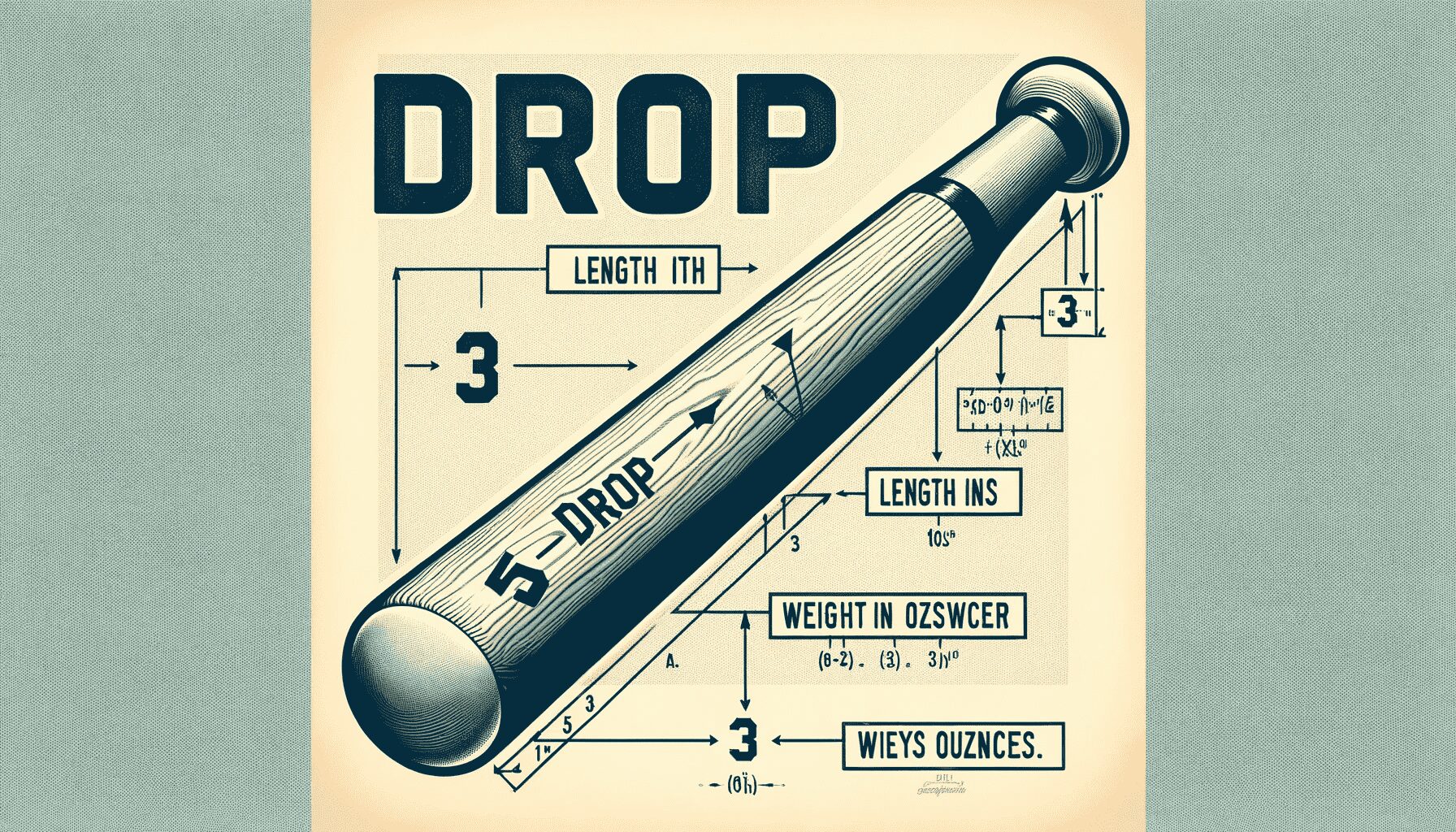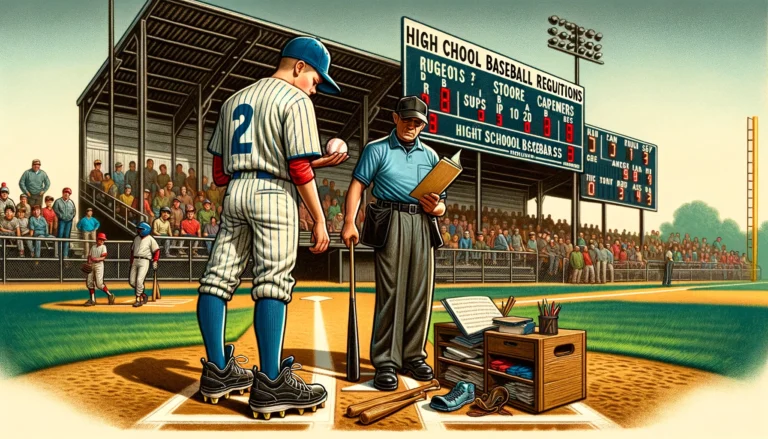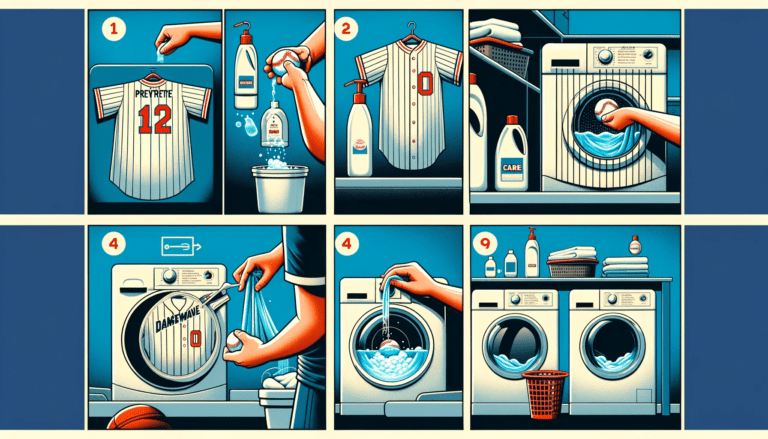What is a Drop 3 Baseball Bat?
Are you curious about what a Drop 3 baseball bat is? In simple terms, a Drop 3 baseball bat refers to the difference between the length and weight of the bat.
When you see a bat labeled as “Drop 3,” it means the weight of the bat is 3 ounces less than the length in inches. This ratio is crucial for players looking for the right bat that suits their swing and hitting style.
Understanding the concept of Drop 3 can help you choose the perfect bat for your game. Let’s look at why the Drop 3 is a key factor in choosing a baseball bat and how it can impact your performance.
Key Takeaways
- Drop weight is a crucial factor in bat selection, defined by the difference between the length of the bat in inches and its weight in ounces.
- A drop 3 bat, with a length-to-weight ratio of -3, is required for players aged 15 and under and in high school, as per baseball regulations.
- The choice of bat, including its drop weight, impacts a player’s swing mechanics and overall batting performance.
- Material and construction of drop 3 bats, such as metal alloy or composite, can influence the bat’s sweet spot and swing weight.
- When purchasing a bat, it’s important to consider shipping guidelines, demo programs, and compliance with league standards.
Exploring the Concept of Drop Weight in Baseball Bats
Defining Drop Weight and Its Importance
The concept of drop weight is fundamental in choosing the right baseball bat. It is calculated by subtracting the bat’s weight in ounces from its length in inches.
For instance, a bat that is 30 inches long and weighs 20 ounces would have a drop weight of -10. The higher the drop number, the lighter the bat feels, allowing for quicker swings.
- Larger, stronger players often prefer bats with a smaller drop weight, as it can lead to enhanced power behind their hits.
- Conversely, smaller or younger players may find that a bat with a greater drop weight helps them achieve faster bat speed, which is crucial for hitting the ball effectively.
Understanding the drop weight is essential not only for comfort and handling but also for adhering to league rules and regulations, which may specify required drop weights for different age groups.
Selecting the appropriate drop weight can significantly impact a player’s performance at the plate.
How Drop Weight Affects Bat Performance
The concept of drop weight is pivotal in understanding how a baseball bat will perform in the hands of a player.
A higher drop weight means a lighter bat, which can significantly influence a player’s swing.
For instance, a bat with a drop of -10 is lighter than one with a drop of -3, making it easier to swing quickly but potentially offering less power behind the ball.
Players often select a bat’s drop weight based on their strength and hitting style. Larger, stronger players may opt for a bat with a lower drop weight, as it can lead to more powerful hits.
Conversely, younger or smaller players might find that a higher drop weight improves their bat speed, allowing for quicker reactions and better handling of fast pitches.
Here are some considerations when assessing how drop weight affects bat performance:
- Bat Speed: Lighter bats can increase bat speed, which is crucial for hitting fast pitches.
- Power: Heavier bats, while harder to swing, can generate more power upon contact.
- Control: Finding the right balance between weight and length can improve control over the bat’s swing path.
- Player Development: As players grow and develop, they may transition to bats with lower drop weights to enhance their power hitting capabilities.
Comparing Drop Weights Across Different Age Groups
Baseball bat regulations vary significantly across different age groups, with each category having specific drop weight requirements.
Younger players, typically under 12 years old, can use bats with any drop weight, allowing for a wide range of options to accommodate their developing skills and strength.
As players mature, the rules become more stringent:
- 13 & Under must use a bat with a drop weight of -8 or heavier
- 14 & Under are required to use at least a drop 5 bat
- Once players reach 15 & Under, they are mandated to use BBCOR-certified bats, which are drop 3
High school players, regardless of age, must also adhere to the BBCOR drop 3 standards. This progression ensures that players high school age are using equipment that matches their physical capabilities and the level of play.
Players and parents must consult a Guide to Bat Size Charts to select the appropriate bat size, taking into account the player’s age and league requirements.
The drop weight, which is the difference between the length of the bat in inches and the weight in ounces, influences the bat’s swing weight and, consequently, the player’s swing mechanics.
Larger, stronger players often opt for bats with less drop weight for increased power, while smaller players may benefit from a lighter bat to enhance bat speed.
Read Also: How Long is a Baseball Bat
The Significance of a Drop 3 Baseball Bat
Characteristics of Drop 3 Bats
A Drop 3 baseball bat is a term used to describe a bat where the drop weight of longer bat, or the difference between the length of the bat in inches and the weight of the bat in ounces, is -3. This means that if a bat is 33 inches long, it will weigh 30 ounces.
The characteristics of Drop 3 bats are particularly important for players who are transitioning to higher levels of play, where regulations often stipulate the use of such bats.
- Standardization: Most wood bats adhere to the -3 drop weight to maintain a standard across different leagues and age groups.
- Material Choices: Players can choose from various materials, including wood types like ash, maple, or birch, and metals, which offer different performance benefits.
- Player Suitability: Larger, stronger players may prefer Drop 3 bats for the potential power gains, while the weight may be challenging for smaller players to handle effectively.
When considering a Drop 3 bat, it’s essential to understand how the drop weight impacts your swing.
For instance, the 2024 Louisville Slugger Atlas™ (-3) BBCOR Baseball Bat is designed with variable barrel thickness to enhance performance.
Whether you’re a power hitter or looking to improve bat speed, the Drop 3 bat could be a critical component of your equipment.
Regulations and Requirements for Drop 3 Bats
Drop 3 baseball bats, designated as BBCOR (Batted Ball Coefficient of Restitution) bats, are subject to specific regulations that ensure safety and fairness in the sport.
These bats must have a length-to-weight ratio of -3, which is a critical requirement for players at certain competitive levels.
For instance, players aged 15 and under, as well as high school players regardless of age, are mandated to use a BBCOR bat. This means that a 33-inch bat must weigh at least 30 ounces.
Adherence to these standards is not only a matter of compliance but also a factor in player development, as using the correct bat can significantly affect a player’s swing and overall performance.
Here’s a quick rundown of the drop weight requirements by age group:
- 12 & Under (12u): Any Drop
- 13 & Under (13u): Must be a DROP 8 or Heavier
- 14 & Under (14u): Must be a DROP 5 or Heavier
- 15 & Under (15u): Must be a BBCOR (Drop 3)
- High School (Regardless of Age): Must be a BBCOR (Drop 3)
It’s important to note that these regulations are subject to updates and changes, so always check the latest league standards before making a purchase.
Advantages of Using a Drop 3 Bat for Players
Drop 3 bats, with a length-to-weight ratio of -3, are a popular choice among high school and college players. This specific drop weight offers a balance that is often considered ideal for developing both bat speed and power.
Here are some of the advantages:
- Enhanced power: Players with enough strength can leverage the heavier weight of a drop 3 bat to generate more power behind their swings.
- Improved precision: The added weight can also contribute to better control over the bat, allowing for more precise hits.
- Regulation compliance: Drop 3 bats meet the requirements for many high school and collegiate leagues, ensuring players are competition-ready.
Choosing a drop 3 bat can be a strategic decision for players transitioning to higher levels of play.
It’s a step up from lighter bats used in youth leagues, preparing players for the standards they will encounter as they advance in their baseball careers.
Read Also: How Many Meters is a Baseball Bat
Choosing the Right Bat: Length-to-Weight Ratio Considerations
Understanding Length-to-Weight Ratio
The length-to-weight ratio, often referred to as the ‘drop’ of a baseball bat, is a critical factor in choosing the right equipment for a player.
It is calculated by subtracting the weight of the bat in ounces from its length in inches. The larger the drop number, the lighter the bat, making it easier to swing.
When selecting a bat, consider the following:
- The age and physical strength of the player.
- The player’s skill level and hitting style.
- League requirements, as they may dictate the permissible drop weight.
For example, players under the age of 12 may use any drop, or one piece bat while those in the 15u category must use a BBCOR-certified drop 3 bat.
Understanding and adhering to these guidelines ensures that players are equipped with the best bats, that enhance their performance while complying with league standards.
Impact of Length-to-Weight Ratio on Swing Mechanics
The length-to-weight ratio, commonly referred to as the ‘drop’, plays a pivotal role in a player’s swing mechanics.
A bat with the correct drop allows for optimal swing speed and control, enhancing a player’s ability to hit the ball effectively.
When the ratio is mismatched to the player’s strength and skill level, it can lead to a decrease in bat speed and a negative impact on swing mechanics.
Choosing the right bat involves several considerations:
- Length: A bat that is too long can hinder bat speed and alter swing mechanics, while one that is too short may reduce plate coverage.
- Weight: The bat should feel comfortable during multiple swings; if it feels heavy or begins to drop, it may be too heavy for the player.
- Feel: Ultimately, the bat must feel right to the player, which includes being able to hold the bat extended for 30 to 45 seconds without discomfort.
It’s recommended to start with a bat length based on the player’s height and weight, and then adjust for the best weight based on personal preference, hitting style, and strength.
The goal is to find the longest and heaviest bat that can be swung without compromising bat speed or swing mechanics.
Selecting the Appropriate Bat for Your Playing Level
When it comes to selecting the perfect baseball bat, personal preference and hitting style are paramount.
Before making a decision, it’s crucial to take practice swings with bats that match your desired length and weight. The material that feels the most natural during these swings is often the best choice.
Understanding your league’s bat standards is essential. For instance, younger players may require a tee ball bat, while those in their teens might need a bat that meets BBCOR standards.
Here are some steps to guide you through the process:
- Review your league’s bat regulations to ensure compliance.
- Measure your height and weight to determine the appropriate bat size.
- Test different materials to find what feels best in your hands.
- Consider your budget, as prices can vary significantly based on bat composition.
Remember, the right bat can enhance your performance and enjoyment of the game. Take the time to find a bat that suits your swing and adheres to league requirements.
Read Also: What Size Baseball Bat for 8 Year Old
Technical Specifications and Player Experiences with Drop 3 Bats
Material and Construction of Drop 3 Bats
Drop 3 bats, which have a length-to-weight ratio of -3, and one piece bats are primarily constructed from two materials: wood and metal.
Wood bats are crafted from various types of trees, including ash, maple, and birch, each offering unique characteristics to the wood bat’s performance.
Metal alloy bats, on the other hand, are popular among beginners due to their affordability and durability, with brands like DeMarini, Easton, and StringKing leading the market.
The construction of these bats also includes features such as different color options and customizable grips, like the Lizard Skins Bat Grips, which range in price and add a personal touch to the bat.
Composite bats, although typically more expensive than balanced bats, provide a larger sweet spot and are favored by experienced players for the additional ‘pop’ they offer.
When selecting a Drop 3 bat, it’s essential to consider the material and construction in relation to the player’s strength and hitting style.
Stronger players may opt for a heavier bat to maximize power, while those seeking to improve bat speed might choose a lighter composite bat model.
Player Feedback on Swing Weight and Sweet Spot
Player experiences with Drop 3 bats often highlight the balance between swing weight and sweet spot size.
Feedback from various users indicates a range of opinions:
- Some players appreciate the balanced swing weight, which can lead to an increase in bat speed and control during the swing.
- Common praise is the bat’s larger sweet spot, which is reported to enhance the hitting experience by providing more pop and a satisfying feel on solid contact.
- However, there are mentions of a small sweet spot on certain models, which may require more precision from the hitter to achieve optimal performance.
Despite the mixed reviews on sweet spot size, the overall sentiment towards Drop 3 bats is positive, with many players noting improvements in their hitting due to the bat’s construction and weight distribution.
Potential buyers need to consider these player insights alongside technical specifications when selecting a bat.
Read Also: What Does Drop 8 Mean in Baseball Bats
Conclusion
In summary, understanding the drop weight of a baseball bat, such as the drop 3, is crucial for players at all levels.
The drop weight, calculated by subtracting the weight of the bat in ounces from its length in inches, helps determine the bat’s suitability for a player’s size and strength.
While larger and stronger players may opt for a bat with less drop weight for increased power, younger or smaller players can benefit from a higher drop weight to enhance bat speed.
It’s also important to note that different age groups and leagues have specific requirements for bat drop weights, making it essential to choose a bat that not only fits the player’s physical capabilities but also adheres to the rules of their baseball division.
Whether you’re a beginner or an experienced player, selecting the right drop weight can have a significant impact on your performance at the plate.
Frequently Asked Questions
What is a drop weight in a baseball bat?
A bat’s drop weight is the measurement determined by subtracting the weight of the bat in ounces from its length in inches. For example, a 30-inch bat that weighs 20 ounces will have a drop weight of -10. The higher the bat control drop number, the lighter the bat.
Why is a drop 3 bat significant in baseball?
A drop 3 bat weight is significant because it is required for play in high school and collegiate leagues, as per BBCOR standards. This drop weight ensures a balance between control and power for players at this level of competition.
What is the length-to-weight ratio and why does it matter?
The length-to-weight ratio, also known as the ‘drop’, indicates the difference between the length of the bat in inches and the weight of the bat in ounces. It matters because it affects a player’s swing mechanics and overall performance at the plate.
Can younger players use any drop weight bat?
Younger players have more flexibility with drop weight choices, but certain leagues have restrictions. For example, 13u must use a drop 8 or heavier, while 14u must use a drop 5 or heavier. Always check league requirements.
How do I choose the correct drop weight for my bat?
Choosing the correct drop weight depends on the player’s size, strength, and hitting style. Larger, stronger players may opt for a bat with less drop weight for more power, while smaller players might benefit from a lighter bat to increase bat speed.
Are drop 3 bats suitable for professional play?
Drop 3 bats are approved for most high school baseball and college play, but professional leagues often have their own regulations. It’s important to check with the specific league’s rules to determine if a drop 3 bat is professionally approved.







